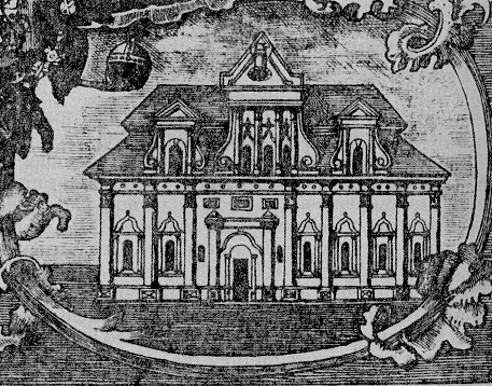Kyivan Cave Monastery Press
Kyivan Cave Monastery Press (Києво-Печерська друкарня; Kyievo-Pecherska drukarnia). The first imprimery in Kyiv and the most important center of printing and engraving in Ukraine in the 17th and 18th centuries. It was founded ca 1606–15 at the Kyivan Cave Monastery by the archimandrite Yelysei Pletenetsky, who purchased the equipment of the former Striatyn Press of Hedeon Balaban in Striatyn, Galicia. Later it was headed by, among others, Zakhariia Kopystensky, Petro Mohyla, Innokentii Gizel (for over 30 years), Varlaam Yasynsky, and Yoasaf Krokovsky. Other prominent Ukrainian cultural figures—the writers Yov Boretsky, Pamva Berynda, Lavrentii Zyzanii, and Ioanikii Galiatovsky; the master printers Stepan Berynda, Tarasii Zemka, and Tymofii Verbytsky; and the engravers Ivan Shchyrsky, Oleksander Tarasevych, Leontii Tarasevych, Ivan Myhura, Nykodym Zubrytsky, Master Prokopii, Master Illia, Andrii Kozachkovsky, and Hryhorii K. Levytsky—also worked there.
The oldest extant book printed by the imprimery is the Horologion of 1616. Other noteworthy books include Antolohion (1619), Pamva Berynda's Slavonic-Ruthenian lexicon (1627), the Kyivan Cave Patericon (1661), Innokentii Gizel's Sinopsis (Synopsis, 1674), and Ifika iieropolitika (1712). The imprimery issued several hundred titles on various subjects, both original works and translations, in Ukrainian, Church Slavonic, Polish, Russian, Latin, and Greek. The books printed included many ecclesiastical and liturgical texts, and also primers, hagiographic studies, Orthodox polemical treatises (see Polemical literature), didactic works, and literary works (panegyrics, emblems, epigrams) by such authors as Sylvestr Kosiv, Petro Mohyla, Lazar Baranovych, Ioanikii Galiatovsky, I. Gizel, Dymytrii Tuptalo, Antin Radyvylovsky, and Teofan Prokopovych. Beautifully engraved and ornamented, they were distributed throughout the Slavic countries, as well as Austria, Greece, and Moldavia. In the 16th and 17th centuries the imprimery played an important role in raising the level of education and culture in Ukraine and in aiding the Orthodox Ukrainians to defend themselves against the inroads of Polonization and Catholicism. The tsarist ukase of 1720 limited it to printing only religious works, which it continued to do until 1918. Its history, by Teodor Titov, was published in Kyiv in 1916.
[This article originally appeared in the Encyclopedia of Ukraine, vol. 2 (1988).]
.jpg)
.jpg)
.jpg)
.jpg)
 (1661).jpg)
 (1703).jpg)
